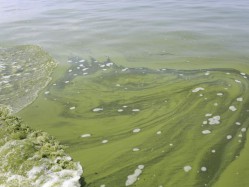 The National Oceanic and Atmospheric Administration’s (NOAA) Harmful Algae Bloom (HAB) Operational Forecast System (OFS), which monitors bloom activity in the Gulf of Mexico from FL through TX, is working its way into the Great Lakes region.
The National Oceanic and Atmospheric Administration’s (NOAA) Harmful Algae Bloom (HAB) Operational Forecast System (OFS), which monitors bloom activity in the Gulf of Mexico from FL through TX, is working its way into the Great Lakes region.
Already, NOAA offers some OFS capabilities, the complete list of which appears via this link, but HAB monitoring is not yet a part.
Look for that to change and, though the HAB monitoring may have limited impact in area that already does a good job of monitoring bacteria levels such as E.coli (see: Wisconsin Beach Health), the extra involvement from NOAA certainly underscores the tremendously negative impact HAB have in freshwater and saltwater ecosystems alike.

